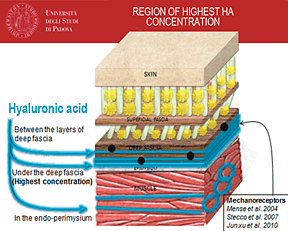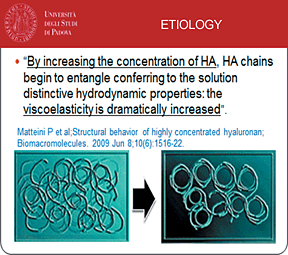An important study in the fascial world by Langevin (2009)1 proposed that people with chronic and recurrent low back pain had 25 percent greater fascial thickness than a low back pain-free group.
She is not alone in her findings. Another study in Skeletal Radiology, 2005,2 found that pathological Achilles tendons showed increased thickness and 89 percent were painful.
Antonio Stecco, MD, recently completed an unpublished study3 using ultrasonography on chronic (longer than 3 months' duration) neck pain patients, evaluating fascial thickness in the distal third of the SCM and scalenus medius. The deep fascia in both muscles were thicker due to the increased amount of loose connective tissue between the layers of the deep fascia (usually three layers) and the loose connective tissue between the deep fascia and the muscle.
 There was a correlation between the intensity of the pain and the thickness of the fascia compared to the control patients. The dense-collagen type I fibers remained the same, while the loose connective tissue demonstrated increased GAGs and hyaluronic acid. (Figure 1) The entanglement of hyaluronic acid (HA) molecules is the apparent cause of increased stiffness and decreased articular ROM.4-5 (Figure 2)
There was a correlation between the intensity of the pain and the thickness of the fascia compared to the control patients. The dense-collagen type I fibers remained the same, while the loose connective tissue demonstrated increased GAGs and hyaluronic acid. (Figure 1) The entanglement of hyaluronic acid (HA) molecules is the apparent cause of increased stiffness and decreased articular ROM.4-5 (Figure 2)
According to Matteini, et al, "These chain-chain interactions were reported to be reversibly disaggregated by an increase in temperature or by alkalization." Moreover, "Recent infrared spectroscopy studies have suggested the formation of three-dimensional superstructures of HA chains stabilized by water bridges. This water-mediated supramolecular assembly was shown to break down progressively when the temperature was increased to over 40° C, in accordance with previous MRI observations."6
 The presence of abnormal HA finally explains many of the fascial treatment explanations whereby pressure against tissue allows a "release" of the area from a gel to a solid. But to change HA entanglements, a major requirement is to increase the temperature several degrees. This might also explain an effect of moist heat. The retention of HA after exercise, as well as its endomysial location, is in accordance with the concept that HA is a substance that is present to lubricate and facilitate the movements between the muscle fibers.3
The presence of abnormal HA finally explains many of the fascial treatment explanations whereby pressure against tissue allows a "release" of the area from a gel to a solid. But to change HA entanglements, a major requirement is to increase the temperature several degrees. This might also explain an effect of moist heat. The retention of HA after exercise, as well as its endomysial location, is in accordance with the concept that HA is a substance that is present to lubricate and facilitate the movements between the muscle fibers.3
Besides the thickening of fascia beneath the deep fascia and muscle, there may be thickening between the superficial and deep fascia, and the intramuscular fascia surrounding perimysium and endomysium. According to the principles of fascial manipulation, it is essential that there be a gliding of the fascial system around and within the muscular tissue;7 otherwise there will be abnormal proprioception, incoordination of muscle function and pain. Graston Technique and deep friction massage are ideal methods to provide the necessary tissue compression and heat for these types of lesions.
References
- Langevin HM,Stevens-Tuttle D, Fox JR, et al. Ultrasound evidence of altered lumbar connective tissue structure in human subjects with chronic low back pain. BMC Musculoskeletal Disorders, 2009;10:151.
- Richards PJ, Win T, Jones PW. The distribution of microvascular response in Achilles tendonopathy assessed by color and power Doppler. Skeletal Radiol, 2005 Jun;34(6):336-42.
- Stecco A. "Evaluation of the Role of Ultrasonography in the Diagnosis of Myofascial Neck Pain." Department of Physical Medicine and Rehabilitation, University of Padua, Italy, 2011.
- Piehl-Aulin K, et al; Hyaluronan in human skeletal muscle of lower extremity: concentration, distribution, and effect of exercise. J Appl Physiol, 1991 Dec;71(6):2493-8.
- Stecco A. Slide presentation on the physiology of fascia. Fascial Manipulation Seminar, Part I, Las Vegas; Feb. 17-19, 2012.
- Matteini P, et al. Structural behavior of highly concentrated hyaluronan. Biomacromolecules, 2009 Jun 8;10(6):1516-22.
- Stecco L, Stecco C. Fascial Manipulation Practical Part. Piccin, Padova, Italy, 2009.
Click here for previous articles by Warren Hammer, MS, DC, DABCO.





